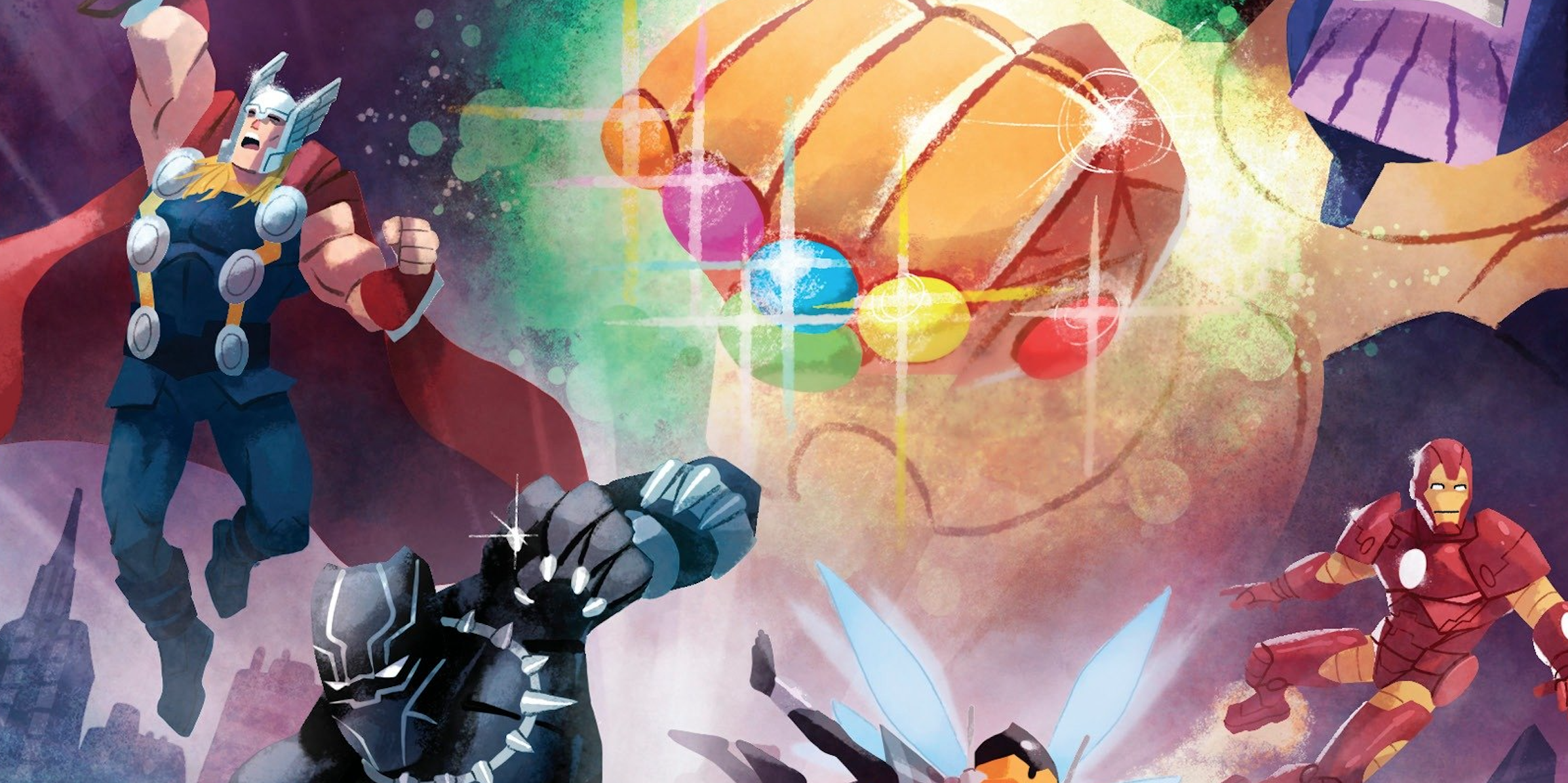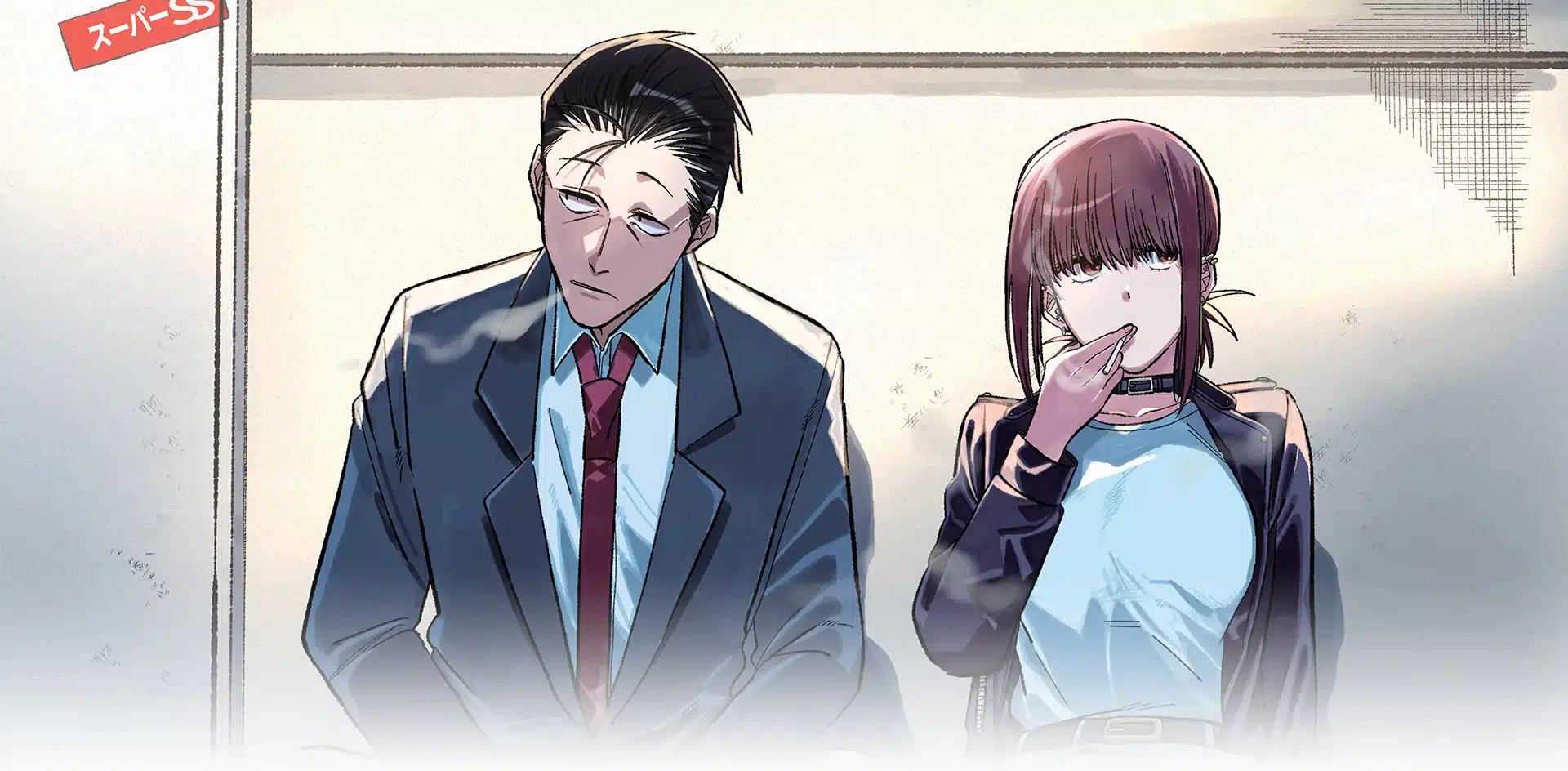Arie Kaplan is one of the most hardworking and prolific writers working in the industry; his upcoming project list is seemingly never-ending. Arie’s output, which runs of the gamut from writing pieces in Mad Magazine, to Superman stories, to LEGO®-inspired book for young readers, is diverse and only broadening in scope. Much of Arie’s most recent work has been aimed at the early reader set, with original stories featuring DC and Marvel stalwarts, including a storybook centered around the big baddie Thanos. It’s all charming and thrilling stuff, while still being appropriate for the wee ones. Not too long ago, I had the chance to chat with Arie about his slate of projects, including the challenge of adapting the mythos of Jurassic Park for little kids, the writing legacy characters from Marvel and Star Wars, and if he snuck a peek at Infinity War before the rest of us!
AJ FROST: Arie! It’s great to chat with you again. It’s been awhile since we sat down to talk, but in the ensuing months, I’ve seen that you’ve been busy working on a lot of interesting pop culture-based writing projects. So, let’s take a quick snapshot. What have you been working on?
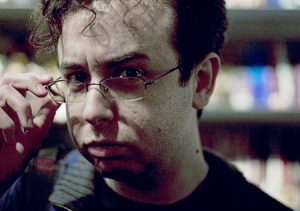
ARIE KAPLAN: Thanks! Yeah, it’s great to chat with you again as well, AJ! Recently, I’ve been working on several “licensed character” children’s books. For example, I’ve written three LITTLE GOLDEN BOOKS. The first two, the DOCTOR STRANGE LITTLE GOLDEN BOOK and the JURASSIC PARK LITTLE GOLDEN BOOK, are both out now. The third one, an AVENGERS LITTLE GOLDEN BOOK called THE THREAT OF THANOS, comes out in July. I co-wrote a book for DK called THE LEGO® DC SUPER HEROES VISUAL DICTIONARY, which comes out in September. I authored an IncrediBuilds book about the CW television series THE FLASH for Insight Editions. And I wrote a LEGO® STAR WARS book, the third LEGO® STAR WARS book I’ve written so far; it’s called THE OFFICIAL FORCE TRAINING MANUAL, and it comes out at the end of September from Scholastic.
FROST: So much to unpack here because this is quite a line-up of material. The first items that catch my eyes are the Little Golden Books, so let’s start there. How does one come to write an Little Golden Book? Is that a pitch you give to the publisher? Or it more the publisher seeks out a writer who really knows the subject matter?
KAPLAN: It’s more of the latter. The publisher seeks out a writer who really knows the subject matter. In this case, what happened was that many years ago, when I was in college, I interned for a book editor named Dennis Shealy. A few years ago, Dennis and I reconnected and by that time, I’d written a few stories for some of the short story anthologies published by Disney Book Group’s Marvel Press imprint. I wrote three stories for a collection called 5-MINUTE AVENGERS STORIES, which came out from Marvel Press in 2015. And I wrote stories for the 5-MINUTE SPIDER-MAN STORIES collection, which came out last year. So I think that showed Dennis that I had experience in writing stories for young children featuring the Marvel superheroes. So Dennis asked if I’d like to write the DOCTOR STRANGE LITTLE GOLDEN BOOK. Of course I said yes! (Honestly, who could say no to that?)
And it was so much fun to write. I did a ton of research while I was writing it, I looked up old Doctor Strange characters from the 1960s and 1970s, figuring out which characters could be most easily adapted to a LITTLE GOLDEN BOOK story. Could we put Clea in here? Can we put Dormammu in here? We’ve GOT to put the Mindless Ones in here! It was such a blast! I guess Dennis liked what I did with that book because last year he asked if I’d like to write the JURASSIC PARK and THREAT OF THANOS LITTLE GOLDEN BOOKS. The JURASSIC PARK one came out in February, in time for the twenty-fifth anniversary of the first JURASSIC PARK movie. And I should mention that the THREAT OF THANOS book is NOT an adaptation of the INFINITY WAR movie, although THREAT OF THANOS does involve Thanos, the Avengers, the Infinity Stones, and the Infinity Gauntlet. But it’s a totally different story than the INFINITY WAR movie.
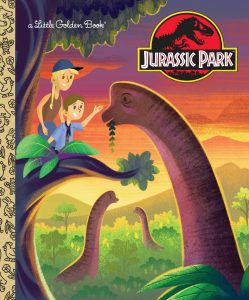
FROST: The Jurassic Park LGB is interesting on its face because its such a juxtaposition. Jurassic Park is not the first film (or book) that one necessarily thinks is appropriate for pre-schoolers. How did you go about adapting the often dark and complex source material into a book that children can enjoy? Or, for that matter, for parents to enjoy reading with their kids?
KAPLAN: That was a really fun, interesting challenge. This was my process: I watched the first JURASSIC PARK movie again and again and again, with a notebook by my side. And I just went through the film, beat by beat, scene by scene, taking notes on which scenes I could adapt for the LITTLE GOLDEN BOOKS audience, and how I could make the basic story more kid-friendly. For example, in the JURASSIC PARK LITTLE GOLDEN BOOK, the dinosaurs never maul or bite anyone, they just roar at the various characters. So right there, you take out any of the violence in the story. Also, you make it more of a lighthearted adventure story where the stakes aren’t as dire. Sure, the characters are trying to escape the dinosaurs and get help and reunite with one another. But they’re not in danger of getting mauled or ripped apart by the dinosaurs. So it’s less of a frightening story for the target audience of a LITTLE GOLDEN BOOKS story, and more of a thrilling yarn, if you will.
And there were a few scenes where I was able to turn what was—in the film—a suspense-laden scene into more of a slapstick-y scene in the LITTLE GOLDEN BOOK. For example, there’s the scene in the movie where John Hammond’s grandkids, Tim and Lex, are hiding from the velociraptors in the kitchen area of the Visitors Center. And one velociraptor thinks it sees Lex’s face, so the dinosaur charges at Lex. But it’s actually just Lex’s reflection in the shiny metal cabinet, and the velociraptor smashes into it. In the movie, this is a REALLY suspenseful scene; it’s so well written and masterfully directed in the movie. But I can’t put that kind of suspense in a LITTLE GOLDEN BOOK – it’s too scary for a young child. So I played that scene for laughs, as though it was a Wile E. Coyote cartoon. Like, the velociraptor smashes into the metal cabinet. WHAP! It’s a nice bit of slapstick in the book. Moments like that, when played for comedic effect, defuse the suspense that would be a bit too intense for very young children reading this book (or being read the book by their parents). I also used Tim and Lex as POV characters as much as possible, because Tim and Lex are kids, so I figured the kids reading the book would relate to them.
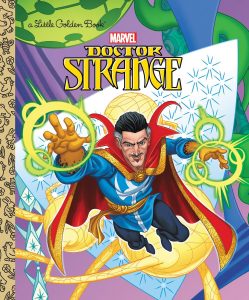
FROST: It seems like you had a ton of fun exploring that flick through news eyes! I wonder…Obviously, you have to stick to some core parts of the license, while adjusting to others to be age-appropriate, but how much leeway are you allowed in these books?
KAPLAN: Quite a bit of leeway, actually. I mean, with the JURASSIC PARK book, I was trying to stay true to the spirit of the film while writing a book that parents (many of whom grew up watching the movie) could feel safe reading to their kids before bedtime. And it needs to have many of the same scenes as the movie, the same basic structure as the movie, but you have to keep thinking, “What’s the ‘Little Golden Books’ way of saying this line?” Or “What’s an image that we can use to illustrate this scene in a more kid-friendly way?” Because when you’re writing a LITTLE GOLDEN BOOK manuscript, not only are you writing the text, you’re also writing the art notes, which are the instructions to the illustrators for what they should be drawing on every page. And those are like stage directions in a play or scene descriptions in a screenplay. Or panel descriptions in a comic book script, for that matter. And having written comic book scripts for well over a decade, I was used to that. So I felt right at home writing the art notes for these LITTLE GOLDEN BOOKS manuscripts. I even drew little thumbnail sketches while I was writing the art notes, just to give myself an idea of how a certain image might look. How would that look, to have a velociraptor bumping its head into a cabinet in a slapstick-y way, for example? Then I could describe what I’d drawn (in the thumbnail sketch) in the art notes. I didn’t show the thumbnail sketches to anyone, not even to my editor. They were just for my reference while I was writing the manuscript, just to help me get into the right head-space to work on the book. And oftentimes, to figure out how to tell a certain part of the story visually. What image would help communicate this story beat?
You have to remember that the JURASSIC PARK LITTLE GOLDEN BOOK was an adaptation of the 1993 JURASSIC PARK movie (which was itself an adaptation of Michael Crichton’s novel). So there was creative leeway, but I couldn’t change the plot or change the ending. It was more about trying to make it fit in a book for very young kids, and in a specific word count and page count. But I had to stick to the plot of the movie, not that I minded. Like I said, it was a fun challenge adapting that movie for a LITTLE GOLDEN BOOK. However, with THE THREAT OF THANOS, I was able to come up with a completely original plot. And because THREAT OF THANOS wasn’t an adaptation, I had more leeway there.
FROST: Did Marvel hip you with any of the secrets of the Infinity War while you were writing the Thanos book? Or did you ever try to pry deeper into what they were working…. for research purposes, as it were? Or were they tightlipped?
KAPLAN: Oh no, I didn’t pry. And really I didn’t talk to anyone at Marvel while writing THE THREAT OF THANOS. Throughout the process of writing that book, I was just talking to my editor, and he gave me any notes Marvel had. Which were pretty minor; Marvel seems to like what I’ve done with both of the Marvel LITTLE GOLDEN BOOKS I’ve written. And I take that as a compliment because it means that I understand the Marvel Universe and the Marvel characters.
FROST: It really must be a lot of fun to be given the keys to play with these world-famous franchises and characters. You mentioned co-writing a dictionary for the DC LEGO® Superhero Universe. How does writing, say, a more “technical” type of book get your creative juices flowing? Is there a different mindset going into the LEGO® books than the LGB books?
KAPLAN: Well, the short answer is yes. It’s a different mindset just because all of the LEGO® books I’ve written so far have been for an older audience than the LITTLE GOLDEN BOOKS I’ve written. But also when I co-wrote the LEGO® DC SUPER HEROES VISUAL DICTIONARY (my co-author on that book was the wonderful Elizabeth Dowsett), it’s a juvenile nonfiction book. So it’s more about explaining various facets of the LEGO® DC SUPER HEROES universe to the reader. Which I found SO much fun, just because I already HAD an “encyclopedia” of sorts of DC Universe knowledge in the back of my head, from reading so many DC comic books as a kid. I seriously remember working on one section of the VISUAL DICTIONARY book, about LEGO® Lex Luthor, and I was just supposed to list some facts about Lex Luthor. Just to give readers an idea of who Lex is in general. And I was like, “Hmmm….What am I even going to WRITE in this section? What do I even KNOW about Lex Luthor?” And at that very moment, this pop culture encyclopedia in the back of my head just INSTANTLY CLICKED ON and downloaded all of these facts about Lex Luthor into my skull. And I was like, “Oh, THAT’s what I know about Lex Luthor! Turns out I know a TON about Lex Luthor!” And writing the whole book – well, my half of the book – was all like that. It was the same way writing the DOCTOR STRANGE LITTLE GOLDEN BOOK, by the way, because that was a “meet the characters” book, so it introduces the audience to all of Doctor Strange’s friends and foes. So that drew on all the Doctor Strange stories I’d read as a kid, which were also in that pop culture encyclopedia in my brain. By the way, my wife Nadine calls that encyclopedia in my brain “The Database.” It’s this reservoir in my head of obscure pop culture trivia. I can’t remember where I put my keys yesterday, but I can remember the names of every cast member of BUCKAROO BANZAI. Which is one of my all-time favorite movies, but that’s neither here nor there. Anyway, for both the LEGO® DC SUPER HEROES VISUAL DICTIONARY and the DOCTOR STRANGE LITTLE GOLDEN BOOK, I did a TON of research. Which is always fun for me. I’ve written several nonfiction books, and I take great pride in my research skills. For the LEGO® DC SUPER HEROES VISUAL DICTIONARY, I had a blast describing and pointing out all of the cool details you can find on any and all of the various LEGO® DC minifigures.
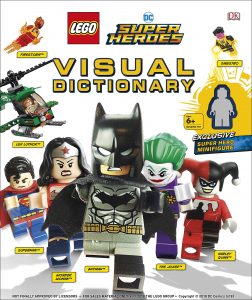
FROST: Are there any franchises you like playing around with more (Star Wars vs. DC, let’s say), or is each its own unique adventure?
KAPLAN: Each franchise is certainly its own unique adventure, and I like playing around with each of them equally. I mean, it’s SO much fun writing those LEGO® STAR WARS books. I’ve written three of them so far – THE OFFICIAL FORCE TRAINING MANUAL is the third – and each time I come back to that universe, it’s just the best. But I should mention that unlike the LEGO® DC SUPER HEROES VISUAL DICTIONARY, which is a nonfiction book, the LEGO® STAR WARS books I’ve written are really more humor books. They have a nonfiction element to them certainly, where you can learn about the gadgets, weapons, and vehicles of the various LEGO® STAR WARS minifigures. But there’s also a steady stream of jokes about the various LEGO® STAR WARS characters throughout the three books I’ve written. And in two of them – THE OFFICIAL STORMTROOPER TRAINING MANUAL and THE OFFICIAL FORCE TRAINING MANUAL – both of those books have activity sections, with games, puzzles, and more, all written by yours truly. And all very silly and jokey.
One other thing: I should mention the artists on the various LITTLE GOLDEN BOOKS I’ve written (I don’t want to be one of those writers who doesn’t mention the artists): The JURASSIC PARK LITTLE GOLDEN BOOK was illustrated by Josh Holtsclaw, the DOCTOR STRANGE LITTLE GOLDEN BOOK was illustrated by Michael Borkowski and Michael Atiyeh, and the THREAT OF THANOS was illustrated by Shane Clester. I really tried to write Thanos as a schoolyard bully in THREAT OF THANOS, and wow, Shane Clester’s artwork really makes Thanos LOOK like a schoolyard bully in that book…albeit an incredibly powerful, alien overlord-style schoolyard bully.
FROST: So you have books coming out in the summer and the upcoming months. Are there any upcoming projects in the works that you’re free to talk about now?
KAPLAN: There are a couple of other projects I’m working on (aside from the ones I’ve already mentioned), but nothing I can talk about just yet. But hopefully soon. This Sunday April 29th, 2018, I’ll be one of the special guests at the Jewish Comic Con in Brooklyn. (More info here: http://jewishcomiccon.org/). The Jewish Comic Con is a great event, and I’ll be moderating many of the panels, in some cases co-moderating them with Danny Fingeroth.
But in general, I just wanted to say that I have a great amount of pride about these projects I’ve been discussing with you, AJ. While I was writing THE THREAT OF THANOS, it was so much fun figuring out a way to explain the Infinity Stones in such a way that young children would understand the Stones (and what each of them can do). When I was writing THE OFFICIAL FORCE TRAINING MANUAL, the book’s narrated by Rey, so I had a fantastic time figuring out how Rey would describe various aspects of the LEGO® STAR WARS universe. I actually have a story about that. Wanna hear it?
FROST: Yes, please!
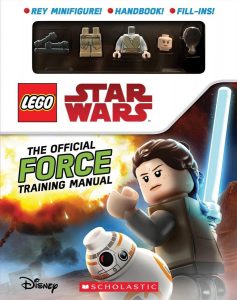
When I was writing THE OFFICIAL STORMTROOPER TRAINING MANUAL, it was narrated by a stormtrooper, so to write a stormtrooper narrator in a wacky, comical way isn’t that much of a challenge. Everyone makes jokes about stormtroopers not being able to shoot straight, so I wrote that stormtrooper narrator as a well-meaning, accident-prone oaf. To him, the Stormtroopers (and Darth Vader and Emperor Palpatine) are the heroes in this story, and the Rebels are the villains. But for THE OFFICIAL FORCE TRAINING MANUAL, how do you make Rey funny? There’s nothing silly or klutzy about her, she’s not pretending to be something she isn’t like Finn in THE FORCE AWAKENS. She’s a very smart, brave, resourceful character. But THE OFFICIAL FORCE TRAINING MANUAL is a humor book, so there had to be something funny about her narration. How do I inject something comedic into Rey’s “narrator voice” and have it still SOUND like Rey? How do I keep it true to the “Rey” character? I was puzzling over this while I was doing the dishes, one night right after I got the gig to write THE OFFICIAL FORCE TRAINING MANUAL. (And I got that gig thanks to my excellent editor at Scholastic, Michael Petranek, who’s hired me to write all three of these LEGO® STAR WARS books. He’s an amazing person to work with.) Anyway, while I was doing the dishes, I decided to listen to an HBO comedy special to pass the time. It was a Russell Brand comedy special. And Russell Brand was talking about how his new attitude in life was one of positive thinking and optimism, and he just sounded so enthusiastic, and his enthusiasm and optimism were infectious. And inspirational. But also funny. And I realized that if I wrote Rey like that— narrating the book in this relentlessly upbeat, enthusiastic, positive way—it would be true to who Rey is, AND it would be funny. So that’s the key to writing a comedic version of Rey: write her like Russell Brand (but the more recent, “positive thinking” version of Russell Brand).
I just wanted to tell you something about the premise behind the OFFICIAL FORCE TRAINING MANUAL, which is this: some of the sections of the book get into a brief explanation of what the Force is, what the Light Side and Dark Side are, what Force-Building is, that sort of thing. And since the book goes into Force-Building, I was also able to write about the FREEMAKER ADVENTURES characters in this book. But it was really interesting unpacking all of that on a level that a kid can understand: what is the Force, what is the Dark Side, what’s a lightsaber, etc. So writing the book was all about explaining all of that stuff in a way a small child can comprehend, and then making jokes about it. Which, I mean… whenever I’ve written one of these LEGO® STAR WARS books, it feels like going home again. STAR WARS is one of my first movie memories. The first time I remember seeing a movie in a theater, it was when I saw EMPIRE STRIKES BACK with my dad. And after Luke fights Vader, when Luke is hanging on to that weather vane for dear life, it really looked to me like he might fall off the weather vane and die! As a young kid, I had no idea that they weren’t going to kill off Luke Skywalker. And I was really worried he was going to die! It was the first time I remember really caring about the characters in a movie that much. So as an adult, to be writing LEGO® STAR WARS books, is…I can’t tell you how much fun that is.
As a comedy writer, I love writing “genre mash-ups.” A few years ago, I was a staff writer on a television series called TruTV PRESENTS: WORLD’S DUMBEST. It was a show where people would send in video clips of themselves or their friends doing stupid things, and then we, the writers, would write jokes and comedy sketches making fun of the clips. I wrote TONS of comedy sketches for that show. But the ones I’m proudest of are the ones that make fun of science fiction or fantasy characters or comic book superheroes. For example, I wrote a sketch about Gollum. I wrote a couple of sketches about Superman for WORLD’S DUMBEST, too. Anyway, WORLD’S DUMBEST was very much a television series for adults. But writing these LEGO® STAR WARS books, and getting to riff on nerdy themes and nerdy subject matter and make jokes about “geek culture” touchstones like Luke Skywalker and Kylo Ren…well, writing a book like THE OFFICIAL FORCE TRAINING MANUAL is sort of like the more kid-friendly version of the work I was doing at WORLD’S DUMBEST: writing nerdy comedy sketches and nerdy jokes.
FROST: Nice! Hey, thanks so much for chatting about all the projects you have coming up!
KAPLAN: Thank you!
Learn more about Arie’s work and upcoming projects over at his website: http://www.ariekaplan.com/


